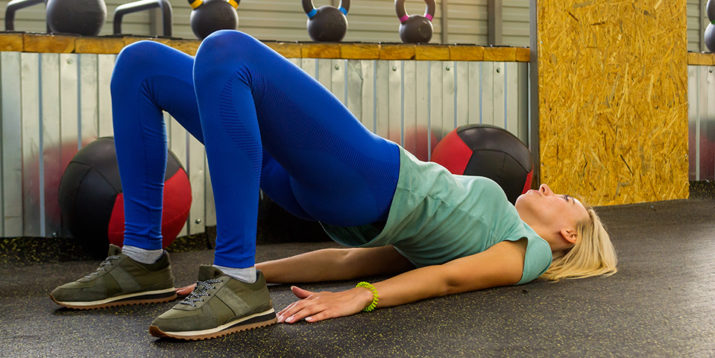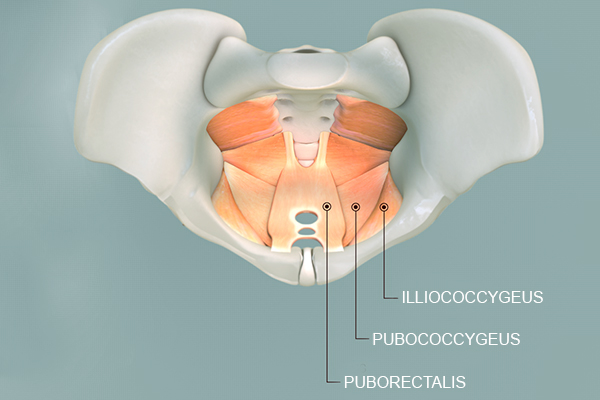5 Pelvic Floor Exercises to Add to Your Workout Routine

When you think core muscles, the usual suspects probably come to mind: the six-pack, the obliques, maybe the transverse abdominis. But there are deeper muscles at the base of your pelvis — referred to colloquially as Kegel muscles — that can be targeted with pelvic floor exercises.
Impact from running and jumping, heavy lifting, and strenuous exertion such as when doing challenging core exercises — heck, even serious chuckles — can significantly increase what is known as intra-abdominal pressure. Other sources of this pressure can include sneezing and coughing, as well as constipation, excess weight from obesity, pregnancy, and an enlarged prostate in men.
Pelvic floor muscles help counterbalance the forces from all of these activities. (Yup, there are muscles that protect you from laughing too hard!)
Libby Hinsley PT, DPT, C-IAYT, a yoga teacher, physical therapist, and author of Yoga for Bendy People, adds, “While it’s important for the pelvic floor muscles to be strong, it’s equally important for them to be supple.”
Training your pelvic floor muscles, which she says you can divide into “squeezers” and “lifters,” yields benefits from improving your sex life to preventing mad dashes for the restroom. And it goes for men as well.
“Pelvic floor exercises are great tools to utilize, especially as we age,” says Cody Braun, CPT. “It’s important to actively focus on maintaining and strengthening our muscular system.”
Here’s all you need to know about your “kegel muscles,” along with the pelvic floor exercises that can help strengthen them.
What Are Pelvic Floor Muscles and What Do They Do?

Your pelvic floor muscles act like a hammock, providing support for organs like the bladder, the colon, the prostate in men, and the vagina in women. They include the pubococcygeus as well as the vaginal and anal sphincter muscles that control the opening and closing of each area.
When pelvic floor muscles are strong they buffer the surrounding organs when intra-abdominal forces increase. Strong pelvic floor muscles can also enhance sexual function — improving the ability to orgasm in women and helping to control premature ejaculation in men.
But when pelvic floor muscles are weak, increased pressure can cause stress incontinence — aka urine or anal leakage. In serious cases, pelvic organ prolapse (in which the walls of the vagina or rectum begin to collapse and extrude) can occur. This condition usually requires surgery to fix.
How Common Are Weak Pelvic Floor Muscles?
Around 25 percent of women report having moderate to severe pelvic disorders (from incontinence to prolapse) according to the The Official Journal of the American Urogynecological Society.
Who is most at risk?
Although being fit and active helps keep pelvic floor muscles strong, some research suggests that women who engage in highly strenuous exercise may be at a slightly higher risk for stress incontinence. A study in the Contemporary Clinical Trials journal noted that 28 to 43 percent of competitive female athletes report experiencing stress-related urinary incontinence.
Having babies increases risk, too. A 2010 study found that one-third of women experienced incontinence in the first three months after giving birth, and women who had vaginal deliveries were twice as likely to experience it. Another study found that nearly as many (~29 percent) still had some stress urinary incontinence four years after childbirth.
Strengthening Pelvic Floor Muscles With Exercise

The good news is that stress incontinence can usually be prevented — or at least dramatically improved — with pelvic floor exercises, simple moves known more commonly as Kegel exercises (rhymes with bagel).
One 2010 review found that up to 70 percent of women who performed these moves for as few as 12 weeks experienced significant improvements in their incontinence.
Kegel exercises are simply pelvic floor muscle squeezes. Although they’ve been around for centuries (notably in ancient yoga and Tantric practices), they were publicly recognized in the United States in the early 1950s when gynecologist Dr. Arnold Kegel published research that used them to treat women with stress incontinence.
How to Do Basic Kegel Exercises
“The Kegel is a general contraction of the pelvic floor, in which both the squeezers and the lifters are activated,” explains Hinsley. “To perform a Kegel properly, contract the muscles you would use to stop the flow of urine.”
But, she adds, “it can be tricky to isolate the right muscles at first, and sometimes the inner thigh or glutes contract as well. It’s important to try to relax and work on isolating just the pelvic floor muscles.” And, in between contractions, relax the muscles completely.
Here’s a simple method:
- Squeeze your glutes tightly.
- As you hold that contraction, squeeze a little more internally and try to contract more muscle specially around the anus.
- If you’re a woman, shift the muscle tension forward once your anal sphincter is activated and squeeze the entrance to the vagina. (If you’ve ever had a tough time pulling out a tampon, that’s due to tight muscles.)
- Men can shift their focus from the anus to the base of the penis and try to move it.
When you’re new to Kegels, it’s easier to do them lying on your back, then progress to seated or standing positions. Focus on quality not quantity, too.
“There isn’t a magic number of repetitions,” Hinsley says. Like any muscle group, strengthening your pelvic floor depends on where you start.
The ideal is holding a lifted contraction against gravity for 10 seconds while you’re in an upright position, but it’s perfectly normal if you need to work up to that.
“Frequency is more important than volume,” she advises. “Practice a little bit each day. A reasonable place to start may be a few sets of 10 to 15 contractions, holding for a few seconds each.”
3 More Pelvic Floor Exercises
“Once you know how to engage the pelvic floor muscles, ideally the body learns to use them automatically as part of the deep-core team of muscles,” says Hinsley.
“When you think about it that way, any exercise can integrate awareness of the pelvic floor,” she adds. Here are three prime examples.
1. Bird dog exercise
- Get down on all fours, with your hands directly below your shoulders and your knees below your hips.
- Keeping your back flat and core engaged, extend your left leg straight behind you and your right arm straight in front of you at the same time.
- Pause, focus on your pelvic floor muscle engagement, and then return to the starting position.
- Repeat with your right leg and left arm. Perform equal reps on both sides.
2. Glute bridge
- Start by lying on your back, with both arms down by your sides. Bend your knees and place your feet on the floor, keeping your heels close to your butt.
- Engage your core muscles by pulling belly button to spine, then squeeze your glutes to press your hips up. Your body will form a straight line from your knees to shoulders.
- Throughout the movement, keep your head on the floor and your gaze toward the ceiling.
- Hold here for a breath, while checking in with your pelvic floor, then lower and repeat.
3. Squat
Over time with practice, the pelvic floor muscles will be strong and responsive enough to support any activity you do.
“More strenuous exercises, such as adding more weight to your squats or lunges, require more core stability, and this includes more support from the pelvic floor muscles,” says Hinsley.
- Stand with your feet hip to shoulder-width apart, arms in front of you for balance.
- Keeping your back flat and core braced, push your hips back, bend your knees, and lower your body until your thighs are parallel to the floor.
- Pause, contract your pelvic floor, then push yourself back up to the starting position.
How to Avoid Peeing During Workouts
If you experience stress incontinence while exercising — or even in more mundane settings like a trampoline or bounce house with your kids — try activating your pelvic floor muscles prior to heavy exertion. So, if you are about to perform a heavy lifting move, or you are about to land from a jump, try to “brace” the muscles just before you feel the increase in internal pressure.
Certain moves such as abdominal curls, jack-knife sit-ups, bicycle crunches, and double leg-lifting core moves (e.g., leg lifts) might increase pressure too much, so you might benefit by choosing other exercise options.
